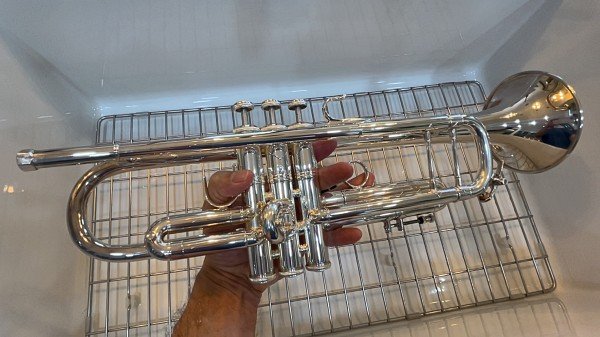How do you clean a trumpet for beginners?
When you first learn how to clean a trumpet, you’ll want to take your time. Read through your owners manual and learn about the process. For easy reference, I made a YouTube video on how to do it with each step shown and explained. I disassembled, cleaned, lubricated, and polished my 70’s Vincent Bach Stradivarius model 180 with a #37 bell. It is silver plated and has had it’s lead pipe replaced due to red rot.
Table of Contents
- How to clean a trumpet expectations
- Trumpet Cleaning Checklist
- How to Clean a Trumpet :Step By Step
- How to Disassemble a Trumpet
- How do you properly wash a trumpet?
- How to reassemble a trumpet
- How do you oil a trumpet?
- How often should a trumpet be cleaned?
- How to make a trumpet swab
How to clean a trumpet expectations
Time: This should take about 20-40 minutes with your first few times taking a longer. The more you do it, the more familiar you are with the process and the unique features of your trumpet.
Care: You’ll want to do this when you are fresh and have no distractions. Your brass instrument is expensive and relatively delicate. You’ll want to take your time to make sure you do things correctly, carefully, and don’t damage anything.
Supplies: You’ll need the cleaning items below and a sink large enough to hold your horn.
Trumpet Cleaning Checklist
- Valve oil (see our guide on the best valve oils )
- Slide Oil
- Slide grease
- Micro fiber clothes I don’t like using a paper towel as they can scratch the delicate silver plating or lacquer finish of your instrument. Further, they can leave lint in your horn.
- Dish soap (the simpler the better, like regular Dawn)
- Brushes (see the cleaning kit below)
- Brush on the end of coated snake
- Valve brush
- Mouthpiece brush
- Polish. If you have a silver plated horn, silver polish will help to remove any tarnish, restore the shine, and protect it.
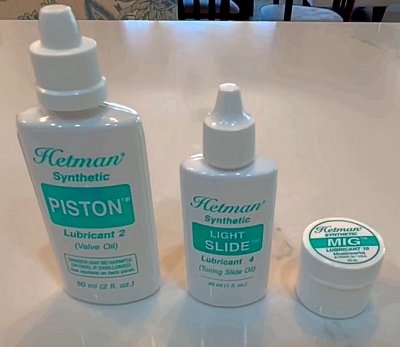
There are trumpet care kits out there that will include everything you need except the cloths and dish soap. A favorite and highly recommended trumpet cleaning kit is available from Yamaha who also just happens to make excellent trumpets and other musical instrument.

How to Clean a Trumpet :Step By Step
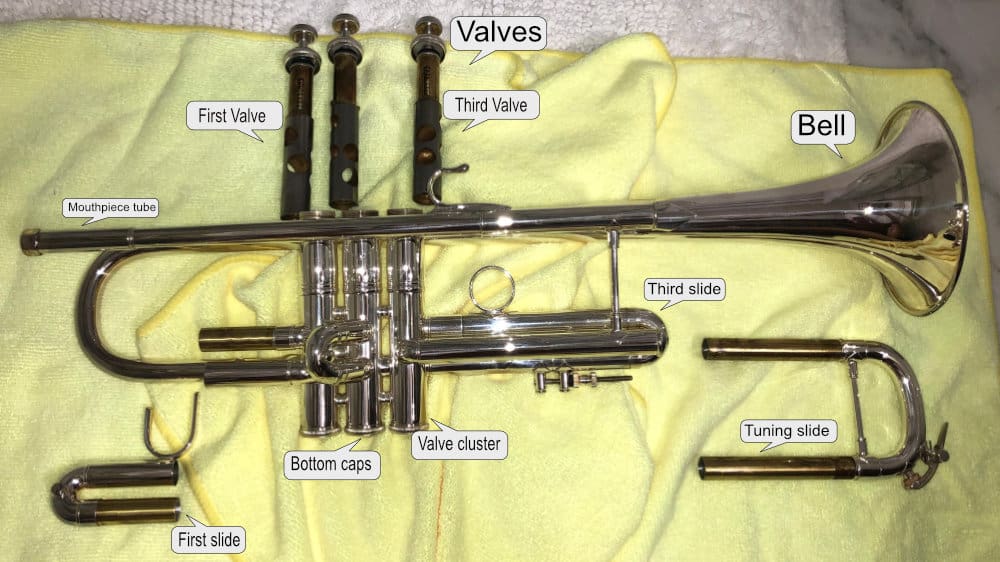
How to Disassemble a Trumpet
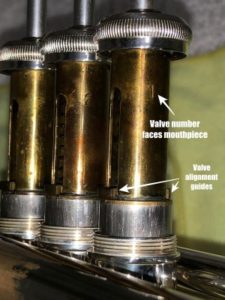
- Lay out a few micro fiber cloths where you can put the parts of your trumpet.
- Unscrew (counter clockwise) the top valve cap (where the stem of each valve come up through) for each valve and slowly pull it straight up and out.
- As you remove each valve, note which way they are oriented. The reason is the valves need to in the exact same orientation as you had them when you remove them. The holes in the them must align with the tubes.
- PRO TIP : Take a picture or two of the valves with your phone like the ones shown below. This way you’ll know exactly how they came out of the valve casing. This will help you to put them back in correctly.
- PRO TIP : Always remove the valves first. The reason is, if you try to remove one of the tubes (for example the first valve tube), the air tight seal of the valve will cause pressure to be put on the valve as you try to remove the tubing which could damage the valve cluster of your instrument.
- Gently place the valves in order (1, 2, 3) on a soft cloth. Valves usually have a number on them. Valve “1” is the one closest to where the mouthpiece goes.
- To make things easy, keep them in order throughout this cleaning process to make reinstallation a breeze.
- Gently remove each slide tube and place them gently on your cloths. The main tuning slide is the big one that has a drain key. That’s a nice name for the spit valve. That one will likely have grease on it so wiping that off will help.
- Unscrew the bottom valve caps.
- Pro tip: If anything takes more than gentle hand pressure to remove, stop and seek the help of a professional instrument repair professional.
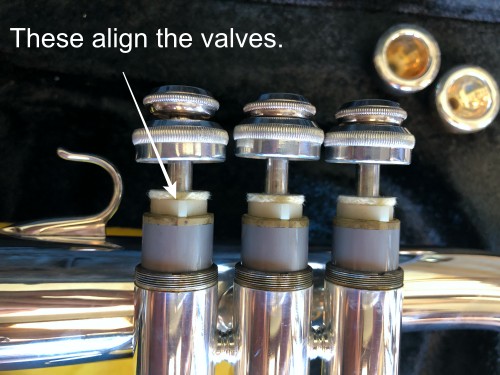
How do you properly wash a trumpet?
- Using a large sink (big enough to fit your trumpet) or a bathtub, fill it up with lukewarm water. While it’s filling, run warm water into the bell and let it flow out through the leadpipe. Push each valve as warm water is running through your horn. Put several drops of dish soap like plain Dawn (because it’s a great degreaser) into the water. Let everything soak in the warm soapy water for 10 minutes or longer if it’s been a while since you last cleaned it. Place each piece part of your horn (except the valves) into the water gently. Don’t forget your mouthpieces.
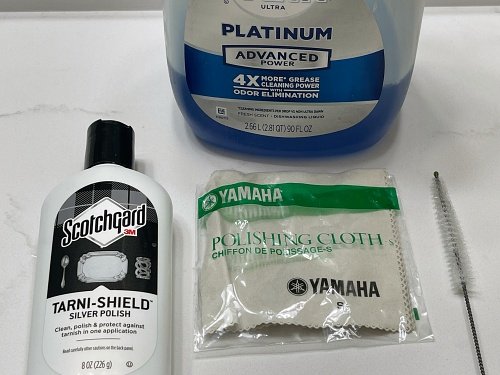
2. Pro Tip: Place a soft cloth on the bottom of the sink or tub to protect your delicate instrument.
3. Pick up the trumpet, being careful not to hit the other parts. Add a drop or two of dish soap in the inner bell or your snake brush head. Using your snake, push it all the way in until you see the brush end first appear in the opening of the first valve cluster tube. Check out the video above if this isn’t clear. Gently push and pull the snake back and forth a few times to clean each tube. Do the same to clean the mouthpiece tube and each tube coming from each valve. Use your valve casing brush to gentle scrub the inner walls of the valve cluster. Rinse thoroughly with fresh lukewarm water a few times.
4. After you wash each piece, dry them gently with your microfiber cloths.
5. To wash each valve, do not soak them. They don’t work as well once wet. Put a drop of dish soap in the palm of your hand and rub it all around the gray part of the valve (the area with the holes). If you see any buildup (green, black, or whatever color gunk) in the holes, use a brush with a drop of dish soap to gentle remove it. Rinse thoroughly with fresh water a few times. Again, avoid getting the felt pads wet. Gently dry and place them onto the soft cloths back in the order and the alignment they were in. Refer back to the pictures you took on your phone.
6. Pro tip: Each valve has a felt cushion just under the top cap. Don’t get them wet when you wash and rinse the valve. They cushion the valve when you release them and they just don’t work as well after they’ve been wet. Again, don’t ask me how I know this and how hard it was to buy new ones before the days of Amazon.
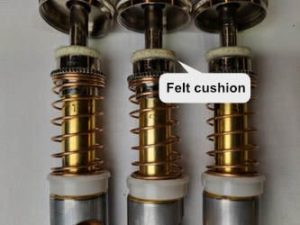
7. Lastly, clean your brass mouthpiece(s) in the same fashion as everything else using your mouthpiece brush. See our post with step by step instructions How to clean a trumpetmouthpiece.
8. The flugelhorn as you can see doesn’t have a main tuning slide like a trumpet. This is where using your cleaning snake with the brush on the end comes in handy.
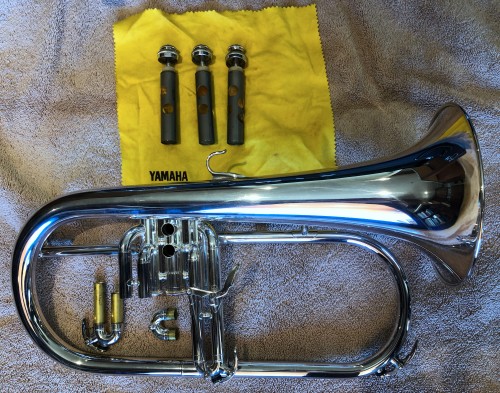
How to reassemble a trumpet
- You’ll want to install the trumpet valves as the last step of reassembly.
- Put some slide grease on each slide (the unfinished brass part) and gently slide them in to place that don’t move a lot. I use slide grease on the main tuning slide, 2nd valve tubing, and the threads of the valve caps (top and bottom).
- For valve tubing slides (ones that move-usually the third and often the first) use slide oil. For ones that don’t move a lot (like the second valve tubing and the main tuning slide) use slide grease.
- Put a little slide grease on the bottom and top screw threads of the valve cluster.
- Apply some valve oil on the first valve. You’ll want to add more than you do when you are adding more valve oil. This is because they are dry. Make sure to coat all around the valve between the holes, especially the bottom part of the valve. Gently slide it in, make sure the valve guide properly seats (there may be a slight click), screw the top cap down (clockwise), and depress the valve a few times to ensure it moves smoothly.
- PRO TIP: Each valve has a key or valve guide that ensures it is installed correctly. Rotating the valve slightly will allow the valve guide to catch and the valve and you shouldn’t be able to rotate the valve at all. Make sure you do that before screwing on the cap. See the nylon guides on the flugelhorn valves above.
- Screw on the bottom caps.
- Wipe down the whole instrument of excess valve oil and slide grease (like the greasy fingerprints on the first slide below.)
- If you have a silver-plated trumpet, use a silver polish or polishing cloth to remove tarnish and protect the finish. Below is an example using 3M Scotchgard Tarni-Sheild on a tarnished Schilke mouthpiece.
- Test your trumpet/flugelhorn. Make sure air goes through the horn with no valves pressed. Then try each valve to ensure they are working properly. If you can’t blow air through the trumpet/flugelhorn, it’s likely a valve is not installed correctly. Unscrew the top valve cap, ensure it is oriented the correct way. Refer to the picture you took when you removed them if you aren’t sure.
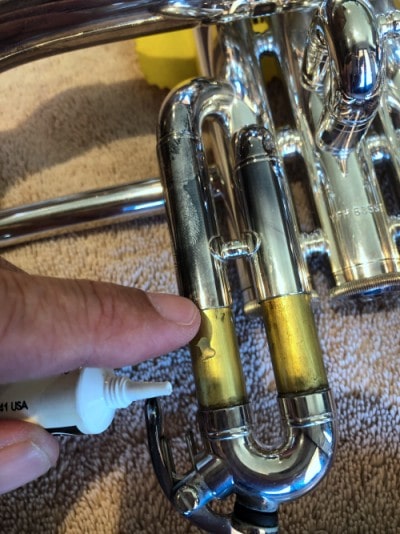
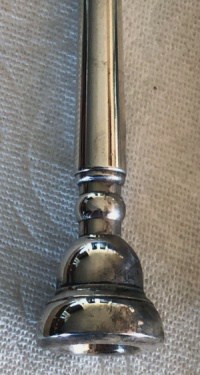
How do you oil a trumpet?
Here’s what type of lubrication you should use on each part of your horn:
Slide grease: Some like to use petroleum jelly. Personally I like to use Hetman MIG (Multipurpose Instrument Grease) which is a synthetic slide grease. Mostly because I can’t stand the smell of petroleum jelly. Use grease on things that should move, but only when you want them to. This include the main tuning slide, the 2nd valve tubing (the shortest one), and the threads of the valve caps (top and bottom).
My rule of thumb is: Apply a little slide grease on slides that don’t move a lot. Use slide oil for ones that do.
Slide oil: Slide oil is a little thicker than grease and is used where things should move quickly but not as fast as the valves. I use it on my first and third valve slides.
Valve oil: This ones the easiest and one you are the most familiar with. When you put the valves back in, they’ll be dry. They won’t have any lubrication on them like when you add more to them when they start to slow down. Put valve oil liberally on the bottom part of the valve and on all of the surfaces around the holes. Please see the video of me doing this if you aren’t sure.
How often should a trumpet be cleaned?
I like to deep clean my trumpet monthly. Granted, I rarely do it every month but it’s something I “like” to do. If you are switching from petroleum based valve oil to a synthetic, you’ll definitely want to clean it with this process. The reason for this is that the two don’t mix well. You’ll end up with a gummy mess. Yes, you are learning from my mistakes on this one.
After playing your trumpet, cornet, or flugelhorn there are a few things you can do to keep it performing great.
First, blow out all the moisture (yes, spit) out of the main tuning slide spit valve. Also, hold down all three valves and blow out with the 3rd valve spit valve open. If you don’t have a 3rd spit valve, remove the end tubing and blow.
How to make a trumpet swab
After every playing session, I blow out as much spit as possible. I then swab out the lead pipe, main tuning slide, and third valve slide. The reason for this is to reduce the chances of red rot. My 1970s Vincent Bach Stradivarius came down with a bad case of red rot in the lead pipe. That’s where it most commonly occurs. Red rot is where the acids in our saliva eat away at the raw brass in the lead pipe. When I had my horn reconditioned and silver plated, they replaced the lead pipe as it was rotted.
I use some heavy fishing line (80 pound test) tied to a small microfiber cloth to dry the leadpipe after every session. The reason is mine rotted out after many decades of being put away damp.
Here’s a video I made on how to make one for yourself.
Here’s some instructions by Yamaha:
Trumpet Maintenance Hack
I use some heavy fishing line (80 pound test) tied to a small microfiber cloth to dry the leadpipe after every session. The reason is mine rotted out after many decades of being put away damp.
Hope this helps you disassemble, clean, lubricate, and polish your trumpet. Now that you are an expert on how to clean a trumpet, you can use these same steps to clean your cornet and flugelhorn. Have fun playing and as always…
Thanks for playing along !


